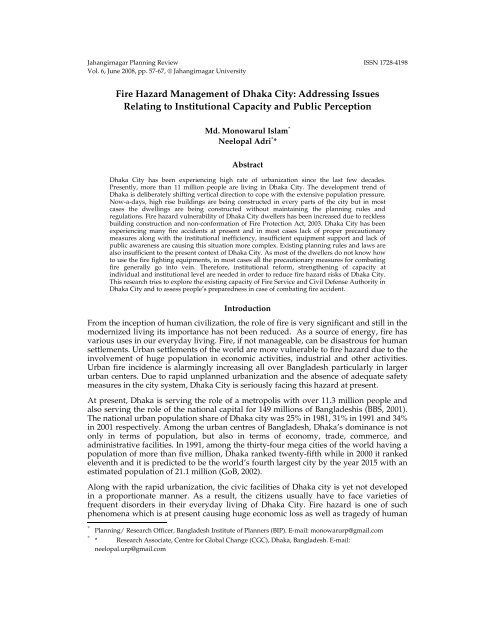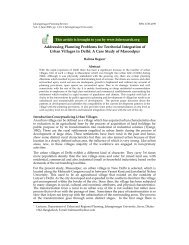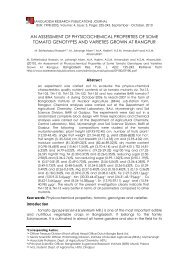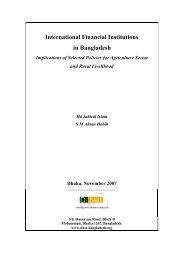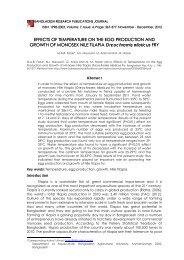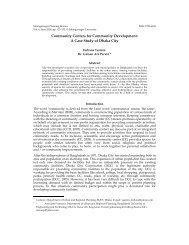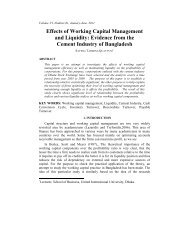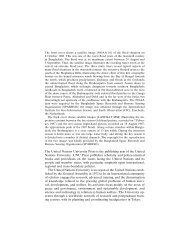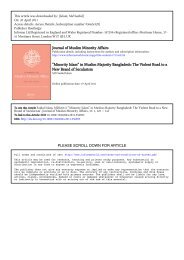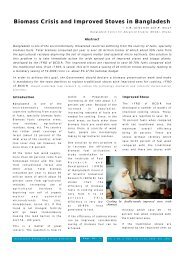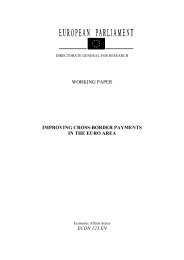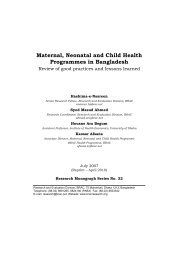FIRE HAZARD MANAGEMENT OF DHAKA CITY: ADDRESSING ...
FIRE HAZARD MANAGEMENT OF DHAKA CITY: ADDRESSING ...
FIRE HAZARD MANAGEMENT OF DHAKA CITY: ADDRESSING ...
Create successful ePaper yourself
Turn your PDF publications into a flip-book with our unique Google optimized e-Paper software.
Jahangirnagar Planning Review ISSN 17284198Vol. 6, June 2008, pp. 5767, © Jahangirnagar UniversityFire Hazard Management of Dhaka City: Addressing IssuesRelating to Institutional Capacity and Public PerceptionMd. Monowarul Islam *Neelopal Adri * *AbstractDhaka City has been experiencing high rate of urbanization since the last few decades.Presently, more than 11 million people are living in Dhaka City. The development trend ofDhaka is deliberately shifting vertical direction to cope with the extensive population pressure.Nowadays, high rise buildings are being constructed in every parts of the city but in mostcases the dwellings are being constructed without maintaining the planning rules andregulations. Fire hazard vulnerability of Dhaka City dwellers has been increased due to recklessbuilding construction and nonconformation of Fire Protection Act, 2003. Dhaka City has beenexperiencing many fire accidents at present and in most cases lack of proper precautionarymeasures along with the institutional inefficiency, insufficient equipment support and lack ofpublic awareness are causing this situation more complex. Existing planning rules and laws arealso insufficient to the present context of Dhaka City. As most of the dwellers do not know howto use the fire fighting equipments, in most cases all the precautionary measures for combatingfire generally go into vein. Therefore, institutional reform, strengthening of capacity atindividual and institutional level are needed in order to reduce fire hazard risks of Dhaka City.This research tries to explore the existing capacity of Fire Service and Civil Defense Authority inDhaka City and to assess people’s preparedness in case of combating fire accident.IntroductionFrom the inception of human civilization, the role of fire is very significant and still in themodernized living its importance has not been reduced. As a source of energy, fire hasvarious uses in our everyday living. Fire, if not manageable, can be disastrous for humansettlements. Urban settlements of the world are more vulnerable to fire hazard due to theinvolvement of huge population in economic activities, industrial and other activities.Urban fire incidence is alarmingly increasing all over Bangladesh particularly in largerurban centers. Due to rapid unplanned urbanization and the absence of adequate safetymeasures in the city system, Dhaka City is seriously facing this hazard at present.At present, Dhaka is serving the role of a metropolis with over 11.3 million people andalso serving the role of the national capital for 149 millions of Bangladeshis (BBS, 2001).The national urban population share of Dhaka city was 25% in 1981, 31% in 1991 and 34%in 2001 respectively. Among the urban centres of Bangladesh, Dhaka’s dominance is notonly in terms of population, but also in terms of economy, trade, commerce, andadministrative facilities. In 1991, among the thirtyfour mega cities of the world having apopulation of more than five million, Dhaka ranked twentyfifth while in 2000 it rankedeleventh and it is predicted to be the world’s fourth largest city by the year 2015 with anestimated population of 21.1 million (GoB, 2002).Along with the rapid urbanization, the civic facilities of Dhaka city is yet not developedin a proportionate manner. As a result, the citizens usually have to face varieties offrequent disorders in their everyday living of Dhaka City. Fire hazard is one of suchphenomena which is at present causing huge economic loss as well as tragedy of human**Planning/ Research Officer, Bangladesh Institute of Planners (BIP). Email: monowarurp@gmail.com* Research Associate, Centre for Global Change (CGC), Dhaka, Bangladesh. Email:neelopal.urp@gmail.com
Jahangirnagar Planning Review, Vol. 6, June 2008 58death in a frequent manner. The reported fire incidences from 2004 to 2006 in Bangladeshwere 7140, 7135 and 9642 respectively; whereas within Dhaka City the incidences wererespectively 803, 984 and 1161 in each year. In 2006, country’s 12% fire accidents occurredin Dhaka city which were 13.79% and 11.2 % in the years of 2005 and 2004 respectively(BFSCDA, 2007). Apart from human death and injury, the damage of property in Dhakacity was estimated to be more than Tk. 6 crore on an average due to fire accidents inevery year (Sayeeduzzaman, 1990). However, this figure has been increased manyfold atpresent. According to the official record of BFSCDA, the monetary loss due to fireaccidents within Dhaka City was Tk. 48 crore in 2007 which was Tk. 80 crore in 2006 andTk. 52 crore in 2005. The annual monetary loss due to fire accidents is very high in DhakaCity compared with the other urban centers in Bangladesh as the city is involved in thehighest concentration of economic activities.The fire safety issue in the large urban areas, like Dhaka is not highly emphasized fromthe city planning perspective in Bangladesh. In most cases, immediately after any largescale fire destruction, the issue of urban safety is highly discussed by local newspapersbut with the progress of time, the issue ultimately fades away from people’s memory. Asa result, the government shows an attitude of reluctance in taking further steps forstrengthening firefighting scenario. At present, the authority of this metropolitan cityhas no contingency plan and sufficient preparation to avoid largescale fire disorders.Moreover, the city authority has no proper equipment and adequate trained manpowerto combat fire hazards particularly in high rise buildings. Unfortunately, very fewresearches have been conducted addressing the issue of urban fire safety in Bangladesh.It may be debatable whether the prevention or mitigation of fire is more feasible forDhaka City, but, there is no doubt that issue should be considered in the planning ofDhaka City.Objectives and Scope of the StudyThe present study tries to explore the fire hazard vulnerability of Dhaka City. The studyalso focuses on fire hazard management scenario of Dhaka City from the point ofinstitutional capacity of Bangladesh Fire Service and Civil Defense (BFSCD) and publicperception of the city dwellers. Furthermore, the study analyzes the legal aspectsregarding fire safety in Bangladesh. However, the research work has covered only thefire hazard vulnerability of the high rise buildings (above six storeys) of Dhaka City. Firefighting capacity at institutional and individual levels was also assessed in this study.Methodology of the StudyIn the primary stage of this study, secondary data has been collected from the relevantpublications, newspapers and Bangladesh Fire Service and Civil Defense Authority’s(BFSCDA) official records. Necessary books and relevant laws were consulted to have aclear concept regarding fire hazard management scenario of Bangladesh. This stage ofstudy helped to conceptualize the existing institutional capacity of fire hazardmanagement in terms of equipments and manpower. Furthermore, a time series analysisof the collected data helped to understand the significance of the issue for Dhaka City.An indepth field survey was carried out in February 2008 to examine the enforcement ofthe existing legal provisions and planning bylaws for fire safety particularly for thehighrise buildings of Dhaka City. Moreover, the awareness of people regarding the firesafety was also addressed in the questionnaire while doing survey. Almost 25 residential
59 Fire Hazard Management of Dhaka City: Addressing Issues Relating to Institutional Capacitybuildings from Gulshan and Old Dhaka and 15 commercial buildings from Motijheel andKawranbazar area were selected randomly for the questionnaire survey.Fire Hazards as an Immerging Issue for Dhaka CitySoon after the liberation war, Dhaka City faced a rapid boom of urbanization. The citynot only expanded in terms of physical dimension but also population and structuraldensity increased very rapidly. The level of urbanization in Dhaka was 29.56 in 1974which increased to 61.48 in 2001 (Rouf and Jahan, 2007). The development trend of thecity took place in a haphazard and unplanned manner with little or no attention to theissue of land use and structural planning which leads to increase occurrence of firehazard nowadays. Increase in population has a subsequent linkage with more frequenturban conflagrations. During 1995 to 1998, the reported fire incidences within Dhaka Citywere respectively 657, 707, 706 and 670 (BFSCDA, 1991). In the last seven years (2001 to2007), the number of incidence has notably increased (Figure 1). Although other forms ofhazards, like cyclone and floods, have overshadowed threat from fire hazard, fires docause considerable damages of the country. Official records from the BFSCDA show thatthe material damage due to fire in the greater Dhaka district (Dhaka, Narayangonj,Manikganj, Narsingdi and Munshiganj) alone was to the tune of Tk. 384.59 million(Maniruzaman and Haque, 2007).Incidence14001200100080060040020002001 2002 2003 2004 2005 2006 2007Y earFig. 1: Reported fire incidence within Dhaka City (20012007).Source: BFSCDA, 2007.A total of 158 people were killed and the property worth about Tk. 3832.69 million wasburned in 6,454 fire incidences within Dhaka City during the period of 2001 to 2007(BFSCDA, 2007). A total of 1,040 fire accidents occurred within Dhaka City only in 2007,of which 4, 129, 302 and 252 occurrences were respectively in slum, industrial, residentialand commercial areas. (BFSCDA, 2007). However, the figures mentioned here are onlythe incidences reported to BFSCDA. There are many minor incidences which are notreported.Number of Death4 0302 01 002 0 0 1 2 0 0 2 2 0 0 3 2 0 0 4 2 0 0 5 2 0 0 6 2 0 0 7Monetary Loss (Millions)1 0 0 080 060 040 020 0020 0 1 20 0 2 20 0 3 20 0 4 20 0 5 20 0 6 20 0 7YearYear
Jahangirnagar Planning Review, Vol. 6, June 2008 60Fig. 2: Death and monetary loss due to fire incidence within Dhaka City (20012007).Source: BFSCDA, 2007.Fire stations in Dhaka City were 12 in the year 1991, which increased to 13 in 2004;whereas the population of the city has increased substantially by this time. In 2001, therewere only an average of 35 fire fighters and two vehicles for each station of the city(BFSCDA, 2007). That means, each fire station has to serve almost 1 million people of thecity where the ratio of the citizen and vehicle is 26,905: 1 and the ratio of the citizen andvehicle is 470,833: 1.The skyline of Dhaka has changed beyond recognition, and the change is taking placefast over the past decade. Two storied and four storied buildings have transformed tohighrise condominium, almost all over the city. At first, there was a limit to the heightand number of stories that could be built including basement garage space in areas likeDhanmondi, Banani, DOHS, Gulshan, Banani and Uttara. The highrise buildings couldbe sixstoried at the maximum. Outside the regulated areas and in commercial areas likeMotijheel, Dilkhusha and Kamal Ataturk Avenue, the statutory limit was much relaxed.Buildings with twenty or twenty five stories were common in those areas. GulshanAvenue, subjected to sixstorey restriction had to give up because of pressure fromdifferent sources and developers got permission to have buildings more than six stories.From a residential area, it quickly became commercial, changing the existing urban plan(Hye, 2006). The city authority has no statistics about the number of high rise buildingswithin Dhaka City.Highrise buildings are now being constructed in different parts of the city and most ofthem are without the provision of adequate fire safety and emergency exit. As a result,the residential and commercial fire in Dhaka City is alarmingly increasing comparedwith the industrial fire (Figure 3). There were 302 residential and 306 commercial fireaccidents against only 129 industrial fires reported in 2007 in Dhaka City. Moreover, thecity has experienced 19 overwhelming high rise fire accidents in year 2007. Somedevastating high rise fire accidents in recent times also marked the capacity of BFSCDAfor fire fighting and fire management of high rise buildings.350Number of Incidence3002502001501005002001 2002 2003 2004 2005 2006 2007YearSlum High Rise Industrial Residential Commercial OthersFig. 3: Occupancy wise accident records within Dhaka City (20012007).Source: BFSCDA, 2007.
61 Fire Hazard Management of Dhaka City: Addressing Issues Relating to Institutional CapacityBFSCDA is the legitimate authority responsible for managing fire hazards in Bangladesh.However, the institution is characterized by weak equipment, poor technology, andinadequate manpower. Despite the drawbacks, the existing 13 fire stations of the citytermed as First Class category, having only two water tenders, a pump, and an average of35 fire fighters for each station (BFSCDA, 2007). The increasing population coupled withlimited enforcement of existing building construction rules or regulations and growthmanagement planning resulted increased fire risk in Dhaka City. Besides, the poor firefighting equipments and absence of infrastructure supports like street fire hydrants andfirelanes in such an overcrowd city the authority often face serious difficulties in firemanagement. The fire prevention section of BFSCDA is authorized to issue license for thebuilding, which is presently facilitated by 27 persons for all over the country and only 4of them responsible for Dhaka City. The existing manpower of RAJUK is not sufficient tomonitor and enforce the building code properly. People of the city also do not have anytraining and not even the minimum perception about how to respond or cope with thefire when an accident occurs.According to the BFSCDA records, ‘electric short circuit’ is the main cause of fireaccidents in Dhaka City (Figure 4). Electric short circuit results mainly from the illegalloose connections, substandard wiring and overloading of the system.Number of Incidence60040020002001 2002 2003 2004 2005 2006 2007YearElectric Short Circuit Fire From Burner Cigarette UnknownAsh/Fuel Playing With Fire Resistance of Equipments IntentionalPeoples Unrest Open Lamp OthersFig. 4: Major causes of fire accidents within Dhaka City (20012007).Source: BFSCDA, 2007.Almost 407 fire accidents occurred due to electric short circuit reported in 2007 and thenumber was 550 and 490 for the year 2005 and 2004 respectively. In 2007, almost 105 fireaccidents originated from the ‘kitchen burner’ in Dhaka City which can be identified asthe second important reason for fire accidents. Every year few ‘intentional fires’ causedin Dhaka city but in most cases the overall loss due to this reason is very high.Intentional fire is an important issue for Dhaka City which is generally the outcome ofinterpersonal conflict, political destabilization and social unrest, especially in slum areas.The institutional strengthening and growth of BFSCDA can not pace with the populationgrowth of Dhaka City. Only one fire station has been added to Dhaka City in last 10years, whereas during the period the population has substantially increased. The numberof manpower and equipments are also very insufficient compared to the presentpopulation of Dhaka City. Moreover, the BFSCDA has no modern communication
Jahangirnagar Planning Review, Vol. 6, June 2008 62system to receive information and to control vehicles properly from the control room. Atpresent, Dhaka City has no formal zoning according to the fire risk vulnerability. Theprime challenges that the authority usually face after a fire call is to reach the spotrapidly considering the low mobility in the road way and to manage water for firefighting. Dhaka City is gradually loosing its natural reservoir and unfortunately the cityhas no plan yet to develop street fire hydrant system. Consciousness of people regardingfire management is also very low. Consequently, in most of the cases after the fireaccidents the fire fighting equipments remain unused. Limited capacity of the concernedauthority together with low mobility in the road way, limited water sources andunconsciousness of the people regarding fire management makes the overall situationcomplex for Dhaka City. As a result, fire incidences are alarmingly increasing and thecity has to accept annual average monetary damage of Tk. 60 crore along with thetragedy of death of many people.Existing Legal Provisions for Fire SafetyAt present, there are various legal instruments and planning bylaws in Bangladesh forcontrolling fire hazards, such as Fire Service Ordinance 1959, East Pakistan Fire Manual,Building Construction Laws 1996, Fire Protection Act 2003, Dhaka Metropolitan BuildingConstruction Act 2007 etc.Only the Bangladesh Fire Service and Civil Defense Authority (BFSCDA) provides firelicense by the subsection of 7 and 8 of Fire Service Ordinance 1959 to warehouse andindustry. According to this rule, the applicant has to apply with a prescribed formaddressing the Director General of FSCDA enclosed with the relevant documents (i.e. aplan in scale of 1 inch = 8 ft of the warehouse or industry, relevant papers that prove thetenure, trade license and also including a statement on a nonjudiciary stamp). Theauthority then examines the provided information by the field inspector. After asatisfactory report from the field inspector, the Director General provides fire license tothe applicant after receiving the prescribed fee. The authority generally provides firelicense for one year. The Ordinance of 1959 also empowers the relevant fire officer ofrespective jurisdictions to investigate any warehouse and industry without furthernotification. Here it should be mentioned that the Ordinance of 1959 can provide firelicense only to warehouse and industry but not for the residential, commercial or othercategory.The Fire Protection Act comes forth in year 2003. The Fire Protection Act 2003 mentionedthe provisions for all the buildings, including highrises and commercial establishments,to have sufficient fire fighting equipments and confirm the measures of public security.The rules mentioned that buildings of six storeys and above must have an emergencyexit, elevator and emergency electricity supply. Also each of the highrises must have anindividual control room and gas and heat detection system. According to the rules, everyhigh rise must have some trained employees to operate the equipments in case of fireoccurrence. But most of the high rises apartments and commercial establishments do notfollow the rules and the equipment remain useless during the occurrence of fires.The Building Construction Law 1996 also provides some measures for the fire safety at theindividual building premises. According to this law, the buildings will be constructedwithin safe distance of open electric line, there will be at least 2.5 meters open spacebetween residential and commercial site (setback standards), and the buildings musthave the provision of emergency exit.
63 Fire Hazard Management of Dhaka City: Addressing Issues Relating to Institutional CapacityThe section 67 of Dhaka Metropolitan Building Construction Act 2007 is subjected to firesafety. This rule confirms all the provisions stated in Fire Protection Act 2003. In addition,this fixes up some standards, requirements and location of an emergency exit at theindividual building level and also provides the option to keep the directional marking tothe emergency exist.Findings from the Field SurveyAn indepth field survey was carried out among the building/apartment owners andowners association of various multistoried commercial and residential complexes ofDhaka City. The major findings of the 40 buildings (25 residential and 15 commercial)from the field survey are as follows:• Surprisingly, in Old Dhaka, there is not a single building available with firefighting equipments. Almost 60% of the buildings have no planning permissionfrom RAJUK and neither any permission of fire safety and about 92% of thebuildings located beside the minor roads have no fire license. The buildings ofShakahari Bazar, Boxibazar, Chawak Bazar have found intermixing of uses as theground floor is using for the storage of various materials or shopping and theupper floors are for living. In most cases, in the ground floor, flammable materialslikeclothing, fiber, plastic equipments are found to be conserved. The electricweiring and gas connections in the residential buildings of Old Dhaka are in greatthreat for the occurrence of fire accidents in any time.• In Gulshan, the apartment dwellers are unconscious regarding the standard ofelectric equipments used in the building and most of them do not have any contactnumber of BFSCDA. Almost 70% of the surveyed buildings in Gulshan have firefighting equipments, but the dwellers are not aware about the use of thoseequipments. About 80% of people have no mental preparedness and precautionagainst any fire incidence. Almost 95% people do not know how to use fireextinguisher and other fire fighting equipments. In average one or two staffworking in the apartment houses, have no training or precaution against fireincidence. The survey found 80% of them having no such training.• In Kawranbazar, out of seven commercial buildings have been surveyed, five ofthem had installation of fire fighting equipments (i.e. fire extinguisher, hose reelsetc.) and generator backup. All the seven commercial buildings have control roomsat the ground floor but the employed staffs at the control room are not properlytrained. The emergency exits of the buildings are locked, and there is no markingto identify the emergency exit.• In Motijheel, out of eight commercial buildings that have been surveyed, three ofthem have no elevator and any power backup. Five of the buildings have noemergency exit. Most of the buildings have no proper central controlling andtrained staff.• The employee engaged in various institutions of the commercial buildings have noprecaution and mental preparedness regarding fire incidence and 80% of them donot know how to use the fire fighting equipments.Problems Related to the Fire Safety of Dhaka CityLimited Enforcement of Rules and Regulations to the Individual Building LevelAt the building premises planning permission involves three significant stages, such as
Jahangirnagar Planning Review, Vol. 6, June 2008 64land use clearance, building permit, and occupancy certificate. At present RAJUK havevery few planners for the city of 11.3 million population. On the other hand, only 4persons are engaged in fire prevention section for providing fire license within DhakaCity. It is quite impossible for this insufficient manpower to enforce the existing legalprovisions properly. The Fire Protection Act 2003 stated that all the buildings constructedbefore 2003, should renew their licenses. At present, in Dhaka City many buildings arebeing constructed without any fire license and even without having any planningpermission of RAJUK, especially at Old Dhaka. The building code does not allowconstruction of any building over six storeys without an elevator. Moreover, anybuilding with 10 or more storeys should have elevators spacious enough to carry patientson stretchers. To have generators standby for the elevators is mandatory, but it is nowroutinely flouted by the developers and building owners due to lack of monitoring andenforcement.The Fire Protection Act 2003 has provisions for all the buildings, including highrises andcommercial establishments, to have sufficient firefighting equipment and to conform tomeasures of public security. But most such buildings do not have them. Most of the highrises in Dhaka do not have any automatic power backup. There is possibility of beingtrapped the inhabitants inside the elevators during the fire occurrence when power is cutoff and elevators become inoperative. There is also a provision for keeping breathingapparatuses in every highrise building but very few of the inhabitants know about theuse of such apparatuses.Limited Practice of Planning Norms in City PerspectiveExcept in some planned areas, Dhaka is more or less an organic city with the substandardenforcement of planning laws. Most of the areas of the city are characterized by narrowroad system which in many cases is obstructing the entrance, movement and maneuverof fire service vehicles at the time of emergency. The low mobility on the road systemalso increases the response time of the authority and ultimately causing serious firedestruction in minor cases. As the number of fire stations is limited and long distance totravel by the fire fighters causing difficulty to provide timely support to the people inmost of the cases.Dhaka City is gradually loosing its retention ponds and natural reservoirs due toexcessive population pressure and unplanned urbanization. Many khals and lakes havebeen subject to encroachment and filled up for construction of buildings. As the city hasno street fire hydrant arrangement and along with the gradual disappearance of naturalwater sources, the fire fighters usually have to face the scarcity of water during the firefighting.Moreover, a land use zoning for Dhaka City is not established. It is very usual to find theindiscriminate intermixing of various uses, such as residential, commercial andindustrial uses together in same location. On the other hand, due to absence of sufficientsetback the structural density of Dhaka City is very high compared with other cities ofBangladesh. Considering these factors, Dhaka City is one of the most fire disaster pronecity of the country.Limited Capacity of the Concerned AuthorityDhaka has been developed in an enormous rate but the life supporting facilities are notdeveloping in the proportionate manner. At present, there are only 13 fire stations withan average of 35 employees along with two vehicles (one water tender and another ispump) for each station in Dhaka City.Moreover, the equipments used by the FSCDA are not modern and characterized by low
65 Fire Hazard Management of Dhaka City: Addressing Issues Relating to Institutional Capacitycapacity considering the high rise buildings of Dhaka City. The incidence of BSECBuilding of Kawaran Bazar at Dhaka in 2007 experienced that fire service authority canprovide equipment support for fire fighting up to 10 th floor. But there are many buildingsabove 10 th floor in Dhaka which are virtually without any type of fire protection servicesupport from concerning authority. The authority also has the lacking of trainedmanpower.BFSCDA has no equipped central controlling system to control of its vehicles properly incase of any emergency. After the commencement of any accident, the vehicles fromvarious stations generally travel to provide the necessary support. But without anycentral control system, in most of cases the vehicles use the same route, which in manytimes causes unexpected traffic congestion and clogging of road for emergency support.The authority does not have any database or sufficient resources to develop risk mappingof Dhaka city which cause serious difficulties for location analysis. Moreover, at presentthe authority has no access to the modern information system (i.e. internet, GIS) and theauthority has almost no research initiative.Intentional Fire and Political UnrestThe political destabilization of the country is very sensitive which often causesintentional fire and intentional damage of property. With limited manpower and firefighting equipments the BFSCDA usually have to involve with such challenge whoseultimate impact cause the failure to provide the necessary support to general people incase of emergency fire.Public Awareness and TrainingOnly public awareness can avoid many incidences of fire destruction and loss of lives.Electric short circuit and spread of fire from the burner are the major causes for firehazards in Dhaka City. Lack of maintenance of the equipments for a long time generallycauses the electric short circuit. Awareness at the individual public level could preventthe occurrence of such fire incidence.Training is an important consideration that can reduce the loss of lives and damage ofproperties. In most cases of the fire incidence, people become very confused in fear andcan not take any appropriate decision to escape away from fire. Ultimately, this iscausing the loss of lives. Various fire fighting equipments are sometimes provided at theindividual building but they are inferior in number, and in many cases located in theisolated places and people do not know how to use these equipments. As a result, theequipment does not provide any benefit at the time of emergency.The crowd of curious people is also another problem that is usually have to face by thefire fighters during their work. Sometimes the crowd becomes too large that they evenclog the movement of fire fighting vehicles towards the target location.Lack of the Government AwarenessThe Government has lack of concern regarding the modernization of the FSCDA. Most ofthe cities in Bangladesh are developing without any emergency action plan. After anytype of destruction these issues are highly discussed and pointed in local newspapers butwith gradual progress of time the incidence ultimately fades away from people’smemory. As a result, the government shows reluctant attitude in taking further steps forstrengthening firefighting capacity.Institutional StrengtheningRecommendations
Jahangirnagar Planning Review, Vol. 6, June 2008 66• Ensure strict enforcement of the existing legal provisions. The manpower of thedevelopment control authority and BFSCDA could be increased gradually in orderto proper monitoring of the law enforcement.• At present, each of the fire stations in Dhaka City is working beyond their capacity.FSCDA have a future plan to construct 193 more stations all over Bangladesh.However, the stations should be constructed on the priority basis. It is necessary toincrease the number of stations within Dhaka City for ensuring better and effectiveservices.• Modern training program should be provided for the staffs of FSCDA. Expertsshould be appointed to demonstrate the efficient rescue service and the handlingprocess of emergency situation. Also the quality of training on Medical FirstResponder (MFR) and Collapsed Structure Search and Rescue (CSR) should beimproved. Also experienced consultants can be appointed for effectivemanagement of fire fighting.• The government should allocate more resources for purchasing modern firefighting equipment such as pump, ambulance, fire vehicles etc. The number ofequipments, should be increased in each station.• Risk allowance should be given to the staffs of fire service so that they can workwith more dedication and interest.• There should be some assigned monitoring team for monitoring the fire fightingpreparedness of different industries and garments and the team should beempowered to cancel the license of the concerned agency. For the convenience, theteam should visit the buildings under construction to inform about the issue.City Planning Perspective• The city authority should take necessary steps to preserve the natural water bodies.Already many water bodies of Dhaka City have been subjected to theencroachment. An urgent initiate is necessary to recover them.• In the unplanned areas, government may take necessary steps to widen the road.Community motivation for participation in this regard is highly encouraged.• The government should fix up appropriate land use zoning. Industrial activity andwarehouses should not get permission in the residential areas. Proper enforcementof setback rules and FAR should be ensured in building construction. A long termplanning is necessary so that the garments industries can be shifted fromresidential areas to the industrial zones.• The risky areas should be demarcated and necessary steps should be taken forremedy. Fire station can be established in the risky locations and in some casesstreet fire hydrants could be installed in limited scale.• The government can construct artificial reservoir on the roof of public buildingsand mosques in the locations where natural water sources is very limited.• Some special smaller sized vehicles can be added to the BFSCDA to provide theservice in the locations with narrow road system. Government can allocatesufficient resources for the strengthening of the authority.Awareness at the Individual Level• Media is one of the most powerful sources for awareness generation. The electronicmedia as well as the newspapers could be an effective source to make peopleaware of fire hazards. Recently ‘Fire Hazard Week’ has been observed in manycities of Bangladesh and undoubtedly such initiatives are the great sources of
67 Fire Hazard Management of Dhaka City: Addressing Issues Relating to Institutional Capacitygenerating awareness among the people.• At present BFSCDA arranges fire drills particularly in the garment factories andindustries in a very limited scale, which requires to be strengthened. The provisionof mandatory training should be arranged for the staff working in variousresidential and commercial buildings.• Some billboards could be put in the prominent locations, street intersections withsome messages that are helpful to make people aware regarding fire safety. Alsothe emergency contact numbers of BFSCDA could be displayed in those billboards.Children at school should be taught about the fire safety and some drills can bearranged.• Electric short circuit and fire from burner are the two prominent causes of fireincidents in Dhaka City which could be reduced through motivation andgeneration and awareness of people at the individual level.ConclusionThe real city is a safe city that ensures the security of living and livelihood of its citizens.Safety issues should be given high priority in the urban areas because of the involvementof huge population in a limited geographical space. At present BFSCDA is working as theemergency service providing organization and the authority has very limitedinvolvement to the planning decision. The city authorities like RAJUK, City Corporationetc. are also characterized by weak institutional capacity. The existing legal provisionsare also limited and needed to be modified for proper enforcement. Dhaka is growing inan unplanned manner and unfortunately the authorities have very limited control overthe development trend. Urban fire hazard management is not only an institutional issue,rather it is much more a planning issue as it involves safety concern of the city dwellers.It would be very difficult for a single organization to provide necessary support for firehazard management of Dhaka City. Fire safety issues should be addressed from theindividual building premises to the city planning level.ReferencesAlam, H. 2005. ‘Fire Law Aside in Most High Rise Buildings’, The Daily New Age, New Age Metro,Dhaka, 10 February 2005.Alam, H. 2007. ‘High Rise Keep Flouting Building Cods: No Fire Fighting and DetectionEquipments in Most Buildings’, The Daily New Age, New Age Front Page, Dhaka, 28February 2007.BBS. 2001. Bangladesh Population Census 2001: Community Series, Zila Dhaka, Bangladesh Bureau ofStatistics, Government of Bangladesh, Dhaka.BFSCDA. 2007. BFSCDA Annual Report 20012007. Published by Bangladesh Fire Service and CivilDefense Authority, Dhaka.GoB. 2002. Bangladesh National Report: Progress of implementation of the Habitat Agenda (19962001).Unlocking the Potential, National Strategy for Accelerated Poverty Reduction (PRSP),Government of the People’s Republic of Bangladesh, http://banglapedia.search.com.bd/Retrieved on 22 May 2007.Hye, H.A. 2006. ‘Sky is the Limit?’, The Daily New Age, Sunday Column, New Age Editorial, 10September 2006, Dhaka.Khan, M.H. 2007. ‘Dhaka this Week’, Holiday Metropolitan, 16 February 2007.Maniruzaman K. M. and Haque, Q. M. F. 2007. ‘Fire Hazard in Dhaka City: A Case Study of theService Area of Mohammadpur Fire Station’, in S. Jahan, and K. M. Maniruzzaman (ed.)Urbanization in BangladeshPatterns, Issues and Approaches to Planning. Dhaka: BangladeshInstitute of Planners (BIP).
Jahangirnagar Planning Review, Vol. 6, June 2008 68Rouf, M. A. and Jahan, S. 2007.’“Spatial and Temporal Patterns of Urbanization in Bangladesh’, inS. Jahan, and K. M. Maniruzzaman (ed.) Urbanization in BangladeshPatterns, Issues andApproaches to Planning. Dhaka: Bangladesh Institute of Planners (BIP).Sayeeduzzaman, M. 1990. ‘A Fire Hazard Assessment Model and Fire Hazard Zone in DhakaSMA’, in M. A. Islam (ed.) Environment, Land Use and Natural Hazards in Bangladesh. Dhaka:University of Dhaka.


